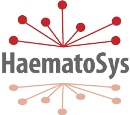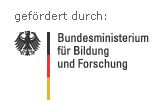HaematoSys
Systembiologie der Hämatopoese und hämatopoetischer Neoplasien
Subproject 1 ¿ Modelling of disease and treatment dynamics
Applicants: Ingo Röder (IR); Andreas Hochhaus (AH); Martin Müller (MM); Dietger Niederwieser (DN); Thoralf Lange (TL)
Associated partners: German CML-trial group; European LeukaemiaNet; F-X. Mahon
Background and own contributions: The availability of TKIs offers a highly efficient method to treat CML patients. However, the occurrence of resistance to TKI is a regular event. Possible intervention strategies, such as the use of 2nd generation TKIs or combination treatments are resistance-type and patients specific. It is currently an open question if and when a specific TKI should be substituted by other TKIs or by a maintenance therapy (e.g. IFN) and whether it can be stopped at all. The development of adequate (patient specific) treatment strategies, requires a detailed understanding of the (residual) disease dynamics, the effects of TKIs and their interactions with dynamic properties of the cells. Here we will apply our proposed model of CML [2.2] which describes the competition of individual HSC clones and relates, in a scale-bridging manner, small (“microscopic”) differences in their kinetics properties to (“macroscopic”) changes in the overall system dynamics. Besides the description of clonal dynamics, the model already presents a option to simulate different treatment scenarios. However, it still needs to be refined and extended to serve as a comprehensive tool for quantitative predictions of patient specific disease dynamics under different treatment scenarios.
Objective: It is our objective to consolidate and extend the previously developed CML model. Particularly, we will amend the model to account for intra-individual clonal heterogeneity (comprising normal, treatment-sensitive, treatment-resistant leukaemic clones) as well as for inter-individual patient heterogeneity (comprising TKI sensitivity, resistance occurrence, and clonal composition). Based on the extended model we will investigate residual disease dynamics, the dynamics of TKI-resistant clones under continuous therapy, as well as competitive/selective growth kinetics of different leukaemic clones in case of treatment alterations. It is the aim to establish a quantitative CML model that predicts individual disease dynamics under variable therapeutic situations and that can be used for the the design of individual treatment schedules and clinical trials.
Available data: BCR-ABL time courses of > 600 patients under first line IM, 2 - 7 year follow-up (AH/MM); > 60 patients with/without IFN (AH/MM, F.-X.Mahon) or Hydroxyurea maintenance (AH/MM) after IM cessation; second-line 2nd generation TKI after IM-failure: Dasatinib – 250 patients, Nilotinib – 200 patients, Bosutinib – 5 patients (AH/MM); highly sensitive time course quantification of IM resistant clones in 40 patients with second line Dasatinib/Nilotinib (DN/TL, AH/MM).
Working program: Modelling strategy. To model the disease and treatment dynamics in CML we apply a stochastic IBM. Within this framework each individual cell develops according to a predefined set of rules. The system dynamics emerge from the interactions of many individual cells which are constrained by systemic feedback (e.g. cell numbers, available resources). The development of a leukaemia is described as a competition process of cells with different individual properties; TKI treatment is modelled as a modulation of this competition process. To account for patient heterogeneity and for different treatment effects on the clonal dynamics, it is inevitable to analyse time course data on the tumour size (measured by BCR-ABL transcript levels) in individual patients. Particularly, we consider different treatment scenarios, including treatment alterations and cessation. Because the occurrence/evolvement of TKI-resistant HSC clones should be comprised in the model, we consider simultaneous measurements on total tumour size and the size of individual TKI-resistant clones. The adaptation/validation of model assumptions and the estimation of optimal model parameters will, therefore, be based on the following three sets of individual patient data. (i) Data on residual disease dynamics: To identify and to explain potential mechanisms underlying the qualitatively and quantitatively different long-term behaviours (such as constantly undetectable BCR-ABL level, fluctuations in BCR-ABL levels without relapse, relapse without detectable resistance mutation), we will model time series of BCR-ABL transcript levels before and after TKI cessation within individual patients. An important issue in this analysis will be the investigation of the hypothesised therapeutic effect of IFN (pre-)treatment in these patients. (ii) Data on TKI-resistant clones under continuous therapy. To identify and to explain the link between long-term BCR-ABL dynamics and the occurrence of therapy resistant (stem cell) clones, we model BCR-ABL levels of patients under IM, dasatinib, nilotinib, or bosutinib therapy. Within these patients the BCR-ABL levels and simultaneously the size of TKI-resistant clones harbouring BCR-ABL mutations had been quantified (partly by two independent, highly sensitive and quantitative PCR-based methods: ARMS-PCR and Ligation-PCR) 3-monthly over a minimum of 1 year. (iii) Data on dynamics and competition of TKI-resistant clones under treatment alterations. We will also model competitive properties of individual clones and the selection pressure induced by coexisting IM-sensitive and IM-resistant clones which are affected differently under altered treatment options. A particular question is whether a specific therapeutic effect on a certain subset of leukaemic clones can induce the expansion of other clones, by altering the competitive balance, and how such competitive effect can be accounted for by controlled therapy alterations. Model predictions and validation. After model consolidation, the model will be used to predict the disease dynamics for particular settings, such as new treatment combinations and/or treatment alterations in individual patients. It is planned to validate the model-based predictions on the bases of independent clinical trial data to be generated in the frame of the European LeukemiaNet.

